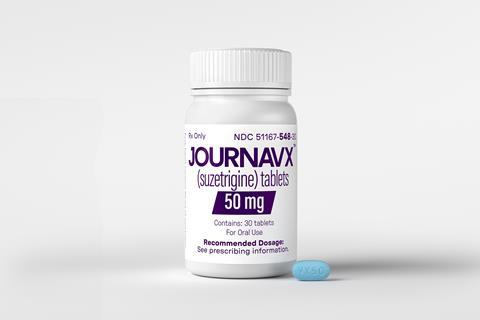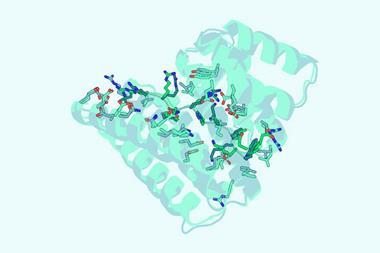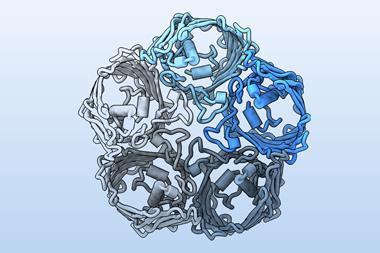Sodium channel blocker prevents nerves transmitting pain signals

For the first time in decades, a new class of painkiller has been approved by the US Food and Drug Administration (FDA). Vertex’s Journavx (suzetrigine) can be used to treat moderate to severe acute pain in adults.
The drug selectively blocks the NaV1.8 sodium channel on nerves that transmit pain signals. NaV1.8 is one of nine sub-types of voltage-gated sodium channels that span cell membranes. When the channels open, sodium ions flow into the cell, changing the electrical potential across the membrane, and triggering an electrical nerve impulse that relays a signal towards the brain.
Several types of sodium channels are involved in pain perception, but NaV1.8 is not found in the brain, so does not trigger pleasure or sensory pathways or cause symptoms such as dizziness or brain fog. In two large patient trials, suzetrigine significantly reduced pain after surgical procedures.
‘A new drug for pain is terrific. That it is a non-opioid is huge. It is what we’re looking for,’ says Allan Basbaum, a neuroscientist at the University of California, San Francisco in the US. Opioids are cheap and highly effective painkillers, but carry addiction risks and can have unpleasant side effects.
Although Journavx is not more effective than opioid drugs, it wins on side effects. Opioids bind receptors in the brain that release feel-good dopamine, leading to dependency. They also hit opioid receptors in the gastrointestinal tract and can cause constipation. Higher doses can induce severe respiratory depression and death.
‘We know [suzetrigine] attaches to a molecule in the peripheral nervous system, not in the brain,’ says Stephen Waxman, a neurologist at Yale School of Medicine in New Haven, US. ‘There’s been no signal of addiction in animal or human studies.’
Remarkably few new drugs have been developed by pain researchers in the last 30 years. ‘I could identify just three,’ says Basbaum: anti-CGRP antibodies for migraine prevention; selective COX-2 inhibitors such as Celebrex (celecoxib) – several of which (including Vioxx (rofecoxib)) have since been withdrawn from the market or seen restricted use owing to cardiovascular safety problems; and Prialt (ziconotide) – a calcium channel-blocking peptide derived from cone snail venom that is injected into the spinal cord. Some medications that are now used to treat pain were developed for other conditions, such as epilepsy drug gabapentin.
‘Some decision-makers within pharma have shied away from pain,’ says Waxman. ‘They ask: why spend valuable resources on such a difficult challenge. Let’s go after inflammatory disease or cancer.’
Suzetrigine is not the first drug to hit sodium channels. Lidocaine – widely used in dentistry and minor surgery – is an extremely effective local anaesthetic, but is not feasible to give systemically, as a pill, because it can inhibit sodium channels essential for brain function and NaV1.5 in heart muscle, causing heart failure.
Interest in subtypes of sodium channels surged after a 2006 report on three families in northern Pakistan with mutations in Nav1.7 that had a complete inability to sense pain. Companies rushed to develop NaV1.7 blockers. They were pharmacologically successful, but clinical results were disappointing.
A Pfizer compound failed in a trial for diabetic peripheral neuropathy, while a late-stage trial for a Biogen candidate (vixotrigine) was halted in 2022.
Researchers broadened their investigations to the related NaV1.8 and NaV1.9 channels. NaV1.9 seems to maintain and modulate the resting potential of nerves, while NaV1.7 readies them for firing. ‘NaV1.7 acts like a fuse, and functions as an amplifier, bringing the cell to the threshold for action of NaV1.8 which acts like the firecracker,’ says Waxman.
While this approval for acute post-operative pain is encouraging, there is a particular need for new medications for chronic pain, since this is where opioids are more likely to become addictive. ‘Pain is the leading cause of disability in the world,’ says Steven P Cohen, a pain clinician at Northwestern University in Chicago, US.
Vertex is trialling suzetrigine for two types of chronic pain – a lower back condition (lumbosacral radiculopathy) and diabetic peripheral neuropathy. Journavx offers partial pain relief, but it may be possible to give alongside other medications, including opioids. Potentially, it could be combined with future inhibitors of NaV1.7 or NaV1.9.
The approval is invigorating for others developing sodium-channel blockers. Latigo Biotherapeutics last year announced positive early results for its own NaV1.8 blocker (LTG-001) and began safety tests in October for another (LTF-305) that targets chronic pain.
Journavx will be more expensive than opioids, which could cause conflicts over access depending on health insurers and national providers’ willingness to cover the cost. ‘Post-operative pain management is usually bundled into surgical costs, and this drug is expensive compared to opiates,’ says Cohen. ‘It therefore might not be used because it eats into hospital profits.’ It may be unavailable or approved only for specific indications in some hospitals, he adds.
The demand for better painkillers remains. ‘Sooner or later, almost all of us experience significant pain and so this is an immense unmet medical need,’ says Waxman.

















No comments yet